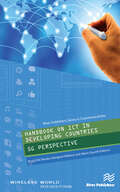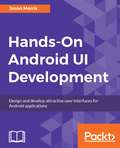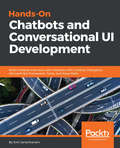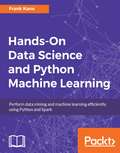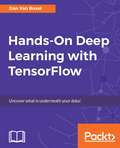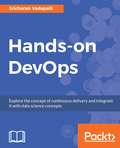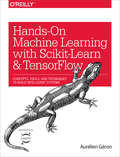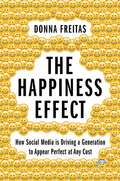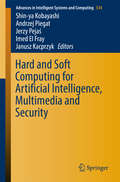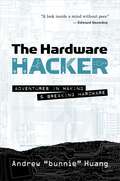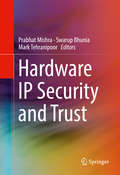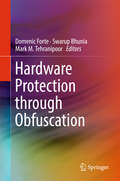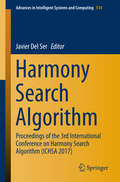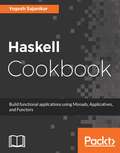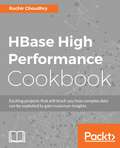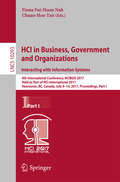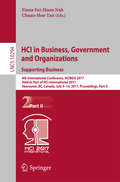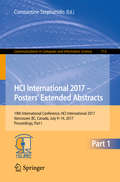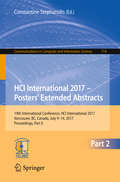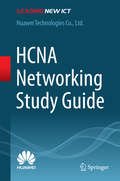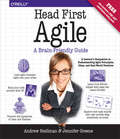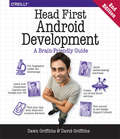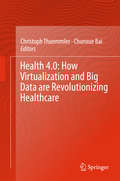- Table View
- List View
Handbook on ICT in Developing Countries: 5G Perspective
by Knud Erik Skouby Idongesit Williams Albert GyamfiThe mobile communications market in developing countries is growing at a rapid rate. This is evident in the rapid spread of mobile broadband cellular networks such as 3G. 4G is also being deployed in developing countries around the world. As the global communications market proceeds towards 5G, it is evident that developing countries will not be left behind. However, there are challenges and barriers on the road ahead specific to developing countries. To aid policy makers, researchers and members of the academia make informed decision that will help the advancement of 5G, this handbook provides an insight into the impact of existing mobile cellular networks in some developing countries. Topics discussed in this handbook include:Digital dividePolicy outlook5G and rural areas5G readinessTelco Business modelsTelecom tower pricingMobile application adoption
Hands-On Android UI Development
by Jason MorrisAbout This BookA comprehensive guide to designing and developing highly interactive user interfaces for your app.Design responsive and agile applications targeting multiple Android devices (up to Android Oreo) using Android Studio 3.0Write reactive user interfaces with minimal effort by leveraging the latest Android technologies, such as Architecture components and the Lifecycle APIAvoid common design problems and pitfalls with the help of shared UI design patterns and best practices.Who This Book Is ForThis book is for novice Android and Java developers who have a basic knowledge of Android development and want to start developing stunning user interfaces.What You Will LearnCreate effective and efficient user interfaces that allow users to carry out tasks smoothlyUnderstand the fundamentals of Android UI design, and take a look at the basic layouts, Inputs, and controlsLearn about various UI components provided by Android which includes structured layout objects and UI controls that allow you to build the graphical user interface for your app.Explore various styles and themes which allow you to customize the look and feel of your app.Leverage the animation and graphics APIs to improve user-experience and drawing custom 2D graphics.In DetailA great user interface can spell the difference between success and failure for any new application. Android UI Development will show you not just how to code great user interfaces, but how to design them as well. This book will take a novice Android developer on a journey, showing them how to leverage the Android platform to produce stunning Android applications. Starting with the basics of creating Android applications, this book progresses onto topics such as screen and layout design. After getting to grips with the basics you'll be shown techniques that create a better-perceived performance. You'll find out how to create reactive applications that are fast, animated and guide the user towards their goals with minimal distraction. You'll explore Android Architecture Components and how to build your application to automatically respond to changes made by the user. Great platforms are not always enough, so Android UI Development also covers creating custom components, layout managers, and 2D graphics. The book contains many tips to help show the best practices and easiest way forward. By the end, you'll be able to not just design & build amazing user interfaces, but also the systems that underpin a great user interface to provide the best possible user experience.
Hands-On Chatbots and Conversational UI Development: Build chatbots and voice user interfaces with Chatfuel, Dialogflow, Microsoft Bot Framework, Twilio, and Alexa Skills
by Phil D Hall Vamsi Venigalla Srini JanarthanamKey Features Understand the different use cases of Conversational UIs with this project-based guide Build feature-rich Chatbots and deploy them on multiple platforms Get real-world examples of voice-enabled UIs for personal and home assistance Book Description Conversation as an interface is the best way for machines to interact with us using the universally accepted human tool that is language. Chatbots and voice user interfaces are two flavors of conversational UIs. Chatbots are real-time, data-driven answer engines that talk in natural language and are context-aware. Voice user interfaces are driven by voice and can understand and respond to users using speech. This book covers both types of conversational UIs by leveraging APIs from multiple platforms. We'll take a project-based approach to understand how these UIs are built and the best use cases for deploying them. We'll start by building a simple messaging bot from the Facebook Messenger API to understand the basics of bot building. Then we move on to creating a Task model that can perform complex tasks such as ordering and planning events with the newly-acquired-by-Google Dialogflow and Microsoft Bot framework. We then turn to voice-enabled UIs that are capable of interacting with users using speech with Amazon Alexa and Google Home. By the end of the book, you will have created your own line of chatbots and voice UIs for multiple leading platforms. What you will learn Design the flow of conversation between the user and the chatbot Create Task model chatbots for implementing tasks such as ordering food Get new toolkits and services in the chatbot ecosystem Integrate third-party information APIs to build interesting chatbots Find out how to deploy chatbots on messaging platforms Build a chatbot using MS Bot Framework See how to tweet, listen to tweets, and respond using a chatbot on Twitter Publish chatbots on Google Assistant and Amazon Alexa
Hands-On Data Science and Python Machine Learning
by Frank KaneThis book covers the fundamentals of machine learning with Python in a concise and dynamic manner. It covers data mining and large-scale machine learning using Apache Spark. About This Book • Take your first steps in the world of data science by understanding the tools and techniques of data analysis • Train efficient Machine Learning models in Python using the supervised and unsupervised learning methods • Learn how to use Apache Spark for processing Big Data efficiently Who This Book Is For If you are a budding data scientist or a data analyst who wants to analyze and gain actionable insights from data using Python, this book is for you. Programmers with some experience in Python who want to enter the lucrative world of Data Science will also find this book to be very useful, but you don't need to be an expert Python coder or mathematician to get the most from this book. What You Will Learn • Learn how to clean your data and ready it for analysis • Implement the popular clustering and regression methods in Python • Train efficient machine learning models using decision trees and random forests • Visualize the results of your analysis using Python's Matplotlib library • Use Apache Spark's MLlib package to perform machine learning on large datasets In Detail Join Frank Kane, who worked on Amazon and IMDb's machine learning algorithms, as he guides you on your first steps into the world of data science. Hands-On Data Science and Python Machine Learning gives you the tools that you need to understand and explore the core topics in the field, and the confidence and practice to build and analyze your own machine learning models. With the help of interesting and easy-to-follow practical examples, Frank Kane explains potentially complex topics such as Bayesian methods and K-means clustering in a way that anybody can understand them. Based on Frank's successful data science course, Hands-On Data Science and Python Machine Learning empowers you to conduct data analysis and perform efficient machine learning using Python. Let Frank help you unearth the value in your data using the various data mining and data analysis techniques available in Python, and to develop efficient predictive models to predict future results. You will also learn how to perform large-scale machine learning on Big Data using Apache Spark. The book covers preparing your data for analysis, training machine learning models, and visualizing the final data analysis. Style and approach This comprehensive book is a perfect blend of theory and hands-on code examples in Python which can be used for your reference at any time.
Hands-On Deep Learning with TensorFlow
by Dan Van BoxelThis book is your guide to exploring the possibilities in the field of deep learning, making use of Google's TensorFlow. You will learn about convolutional neural networks, and logistic regression while training models for deep learning to gain key insights into your data. About This Book • Explore various possibilities with deep learning and gain amazing insights from data using Google's brainchild-- TensorFlow • Want to learn what more can be done with deep learning? Explore various neural networks with the help of this comprehensive guide • Rich in concepts, advanced guide on deep learning that will give you background to innovate in your environment Who This Book Is For If you are a data scientist who performs machine learning on a regular basis, are familiar with deep neural networks, and now want to gain expertise in working with convoluted neural networks, then this book is for you. Some familiarity with C++ or Python is assumed. What You Will Learn • Set up your computing environment and install TensorFlow • Build simple TensorFlow graphs for everyday computations • Apply logistic regression for classification with TensorFlow • Design and train a multilayer neural network with TensorFlow • Intuitively understand convolutional neural networks for image recognition • Bootstrap a neural network from simple to more accurate models • See how to use TensorFlow with other types of networks • Program networks with SciKit-Flow, a high-level interface to TensorFlow In Detail Dan Van Boxel's Deep Learning with TensorFlow is based on Dan's best-selling TensorFlow video course. With deep learning going mainstream, making sense of data and getting accurate results using deep networks is possible. Dan Van Boxel will be your guide to exploring the possibilities with deep learning; he will enable you to understand data like never before. With the efficiency and simplicity of TensorFlow, you will be able to process your data and gain insights that will change how you look at data. With Dan's guidance, you will dig deeper into the hidden layers of abstraction using raw data. Dan then shows you various complex algorithms for deep learning and various examples that use these deep neural networks. You will also learn how to train your machine to craft new features to make sense of deeper layers of data. In this book, Dan shares his knowledge across topics such as logistic regression, convolutional neural networks, recurrent neural networks, training deep networks, and high level interfaces. With the help of novel practical examples, you will become an ace at advanced multilayer networks, image recognition, and beyond. Style and Approach This book is your go-to guide to becoming a deep learning expert in your organization. Dan helps you evaluate common and not-so-common deep neural networks with the help of insightful examples that you can relate to, and show how they can be exploited in the real world with complex raw data.
Hands-on DevOps: Explore the concept of continuous delivery and integrate it with data science concepts
by Sricharan Vadapalli Prakash Sarma Jason MyerscoughKey FeaturesLearn the concepts of Bigdata and Devops and Implement themGet Acquainted with DevOps Frameworks Methodologies and Tools A practical approach to build and work efficiently with your big data clusterGet introduced to multiple flavors of tools and platforms from vendors on Hadoop, Cloud, Containers and IoT OfferingsIn-Depth Technology understanding on Data Sciences, Microservices, BigdataBook DescriptionDevOps strategies have really become an important factor for big data environments.This book initially provides an introduction to big data, DevOps, and Cloud computing along with the need for DevOps strategies in big data environments. We move on to explore the adoption of DevOps frameworks and business scenarios. We then build a big data cluster, deploy it on the cloud, and explore DevOps activities such as CI/CD and containerization. Next, we cover big data concepts such as ETL for data sources, Hadoop clusters, and their applications. Towards the end of the book, we explore ERP applications useful for migrating to DevOps frameworks and examine a few case studies for migrating big data and prediction models.By the end of this book, you will have mastered implementing DevOps tools and strategies for your big data clusters.What you will learnLearn about the DevOps culture, its frameworks, maturity, and design patternsGet acquainted with multiple niche technologies microservices, containers, kubernetes, IoT, and cloud Build big data clusters, enterprise applications and data science modelsApply DevOps concepts for continuous integration, delivery, deployment and monitoringGet introduced to Open source tools, service offerings from multiple vendorsStart digital journey to apply DevOps concepts to migrate big data, cloud, microservices, IoT, security, ERP systems
Hands-On Machine Learning with Scikit-Learn and TensorFlow: Concepts, Tools, and Techniques to Build Intelligent Systems
by Aurélien GéronGraphics in this book are printed in black and white.Through a series of recent breakthroughs, deep learning has boosted the entire field of machine learning. Now, even programmers who know close to nothing about this technology can use simple, efficient tools to implement programs capable of learning from data. This practical book shows you how.By using concrete examples, minimal theory, and two production-ready Python frameworks—scikit-learn and TensorFlow—author Aurélien Géron helps you gain an intuitive understanding of the concepts and tools for building intelligent systems. You’ll learn a range of techniques, starting with simple linear regression and progressing to deep neural networks. With exercises in each chapter to help you apply what you’ve learned, all you need is programming experience to get started. Explore the machine learning landscape, particularly neural nets; Use scikit-learn to track an example machine-learning project end-to-end; Explore several training models, including support vector machines, decision trees, random forests, and ensemble methods; Use the Tensor; Flow library to build and train neural nets; Dive into neural net architectures, including convolutional nets, recurrent nets, and deep reinforcement learning; Learn techniques for training and scaling deep neural nets; and apply practical code examples without acquiring excessive machine learning theory or algorithm details.
The Happiness Effect: How Social Media is Driving a Generation to Appear Perfect at Any Cost
by Donna Freitas Christian SmithSexting. Cyberbullying. Narcissism. Social media has become the dominant force in young people's lives, and each day seems to bring another shocking tale of private pictures getting into the wrong hands, or a lament that young people feel compelled to share their each and every thought with the entire world. Have smartphones and social media created a generation of self-obsessed egomaniacs? <p>Absolutely not, Donna Freitas argues in this provocative book. And, she says, these alarmist fears are drawing attention away from the real issues that young adults are facing.
Happy Mum, Happy Baby: My adventures into motherhood
by Giovanna FletcherCONTAINS A BRAND NEW CHAPTERSunday Times Number One Bestseller Happy Mum Happy Baby is now a Number One podcast. A positive and uplifting book about what it is to be a mother and all things mum and baby by Celebrity Mum of the Year and phenomenally popular vlogger, author, TV presenter and actress Giovanna Fletcher.Being a mum is an incredible journey, a remarkable experience that changes how we look, how we feel, who we are. As mothers we are strong, protective, proud. We feel a love like no other.But being a parent can be hard too. It challenges us physically, mentally, emotionally. There are the days where just managing to fit a shower in amidst the endless feeding, entertaining young children and surviving on a lack of sleep feels like an achievement. With so many people ready to offer 'advice' on the best way to parent, it can feel like you are getting it all wrong.Since Giovanna and her husband Tom Fletcher have had their sons Buzz and Buddy, they have been sharing glimpses of their family life. With an infectiously positive outlook and happy take on all things mum-related, Giovanna has developed a following of fellow parents and mums-to-be.This is not a book about how to have the perfect family experience - Gi would be the first to admit she is winging it just as much as the rest of us - instead it is an honest, upbeat and incredibly personal account of her own experience of having a family. In Happy Mum, Happy Baby Giovanna shares her own journey through parenthood and in doing so, she looks at what it is to be a mother today, encourages you to be confident in yourself as a parent and celebrates how putting a focus on being a happy and confident mum can really make for a happy baby.
Happy Mum, Happy Baby: My adventures into motherhood
by Giovanna FletcherBeing a mum is an incredible journey, a remarkable experience that changes how we look, how we feel, who we are. As mothers we are strong, protective, proud. We feel a love like no other.But being a parent can be hard too. It challenges us physically, mentally, emotionally. There are the days where just managing to fit a shower in amidst the endless feeding, entertaining young children and surviving on a lack of sleep feels like an achievement. With so many people ready to offer 'advice' on the best way to parent, it can feel like you are getting it all wrong.Since Giovanna and her husband Tom Fletcher have had their sons Buzz and Buddy, they have been sharing glimpses of their family life. With an infectiously positive outlook and happy take on all things mum-related, Giovanna has developed a following of fellow parents and mums-to-be.This is not a book about how to have the perfect family experience - Gi would be the first to admit she is winging it just as much as the rest of us - instead it is an honest, upbeat and incredibly personal account of her own experience of having a family. In Happy Mum, Happy Baby Giovanna shares her own journey through parenthood and in doing so, she looks at what it is to be a mother today, encourages you to be confident in yourself as a parent and celebrates how putting a focus on being a happy and confident mum can really make for a happy baby.(P)2017 Hodder & Stoughton
Hard and Soft Computing for Artificial Intelligence, Multimedia and Security
by Shin-Ya Kobayashi Andrzej Piegat Jerzy Pejaś Imed El Fray Janusz KacprzykThis book gathers the proceedings of the 20th International Conference on Advanced Computer Systems 2016, held in Międzyzdroje (Poland) on October 19-21, 2016. Addressing topics that include artificial intelligence (AI), software technologies, multimedia systems, IT security and design of information systems, the main purpose of the conference and the book is to create an opportunity to exchange significant insights on this area between science and business. In particular, this expertise concerns the use of hard and soft computational methods for artificial intelligence, image and data processing, and finally, the design of information and security systems. The book contains a collection of carefully selected, peer-reviewed papers, combining high-quality original unpublished research, case studies, and implementation experiences.
The Hardware Hacker Adventures in Making and Breaking Hardware
by Andrew Bunnie" HuangFor over a decade, Andrew "bunnie" Huang, one of the world's most esteemed hackers, has shaped the fields of hacking and hardware, from his cult-classic book Hacking the Xbox to the open-source laptop Novena and his mentorship of various hardware startups and developers. In The Hardware Hacker, Huang shares his experiences in manufacturing and open hardware, creating an illuminating and compelling career retrospective. Huang's journey starts with his first visit to the staggering electronics markets in Shenzhen, with booths overflowing with capacitors, memory chips, voltmeters, and possibility. He shares how he navigated the overwhelming world of Chinese factories to bring chumby, Novena, and Chibitronics to life, covering everything from creating a Bill of Materials to choosing the factory to best fit his needs. Through this collection of personal essays and interviews on topics ranging from the legality of reverse engineering to a comparison of intellectual property practices between China and the United States, bunnie weaves engineering, law, and society into the tapestry of open hardware. With highly detailed passages on the ins and outs of manufacturing and a comprehensive take on the issues associated with open source hardware, The Hardware Hacker is an invaluable resource for aspiring hackers and makers.
Hardware IP Security and Trust
by Prabhat Mishra Swarup Bhunia Mark TehranipoorThis book provides an overview of current Intellectual Property (IP) based System-on-Chip (SoC) design methodology and highlights how security of IP can be compromised at various stages in the overall SoC design-fabrication-deployment cycle. Readers will gain a comprehensive understanding of the security vulnerabilities of different types of IPs. This book would enable readers to overcome these vulnerabilities through an efficient combination of proactive countermeasures and design-for-security solutions, as well as a wide variety of IP security and trust assessment and validation techniques. This book serves as a single-source of reference for system designers and practitioners for designing secure, reliable and trustworthy SoCs.
Hardware Protection through Obfuscation
by Domenic Forte Swarup Bhunia Mark M. TehranipoorThis book introduces readers to various threats faced during design and fabrication by today's integrated circuits (ICs) and systems. The authors discuss key issues, including illegal manufacturing of ICs or "IC Overproduction," insertion of malicious circuits, referred as "Hardware Trojans", which cause in-field chip/system malfunction, and reverse engineering and piracy of hardware intellectual property (IP). The authors provide a timely discussion of these threats, along with techniques for IC protection based on hardware obfuscation, which makes reverse-engineering an IC design infeasible for adversaries and untrusted parties with any reasonable amount of resources. This exhaustive study includes a review of the hardware obfuscation methods developed at each level of abstraction (RTL, gate, and layout) for conventional IC manufacturing, new forms of obfuscation for emerging integration strategies (split manufacturing, 2. 5D ICs, and 3D ICs), and on-chip infrastructure needed for secure exchange of obfuscation keys- arguably the most critical element of hardware obfuscation.
Harmony Search Algorithm
by Javier Del SerThis book presents state-of-the-art technical contributions based around one of the most successful evolutionary optimization algorithms published to date: Harmony Search. Contributions span from novel technical derivations of this algorithm to applications in the broad fields of civil engineering, energy, transportation & mobility and health, among many others and focus not only on its cross-domain applicability, but also on its core evolutionary operators, including elements inspired from other meta-heuristics. The global scientific community is witnessing an upsurge in groundbreaking, new advances in all areas of computational intelligence, with a particular flurry of research focusing on evolutionary computation and bio-inspired optimization. Observed processes in nature and sociology have provided the basis for innovative algorithmic developments aimed at leveraging the inherent capability to adapt characterized by various animals, including ants, fireflies, wolves and humans. However, it is the behavioral patterns observed in music composition that motivated the advent of the Harmony Search algorithm, a meta-heuristic optimization algorithm that over the last decade has been shown to dominate other solvers in a plethora of application scenarios. The book consists of a selection of the best contributions presented at ICHSA, a major biannual event where leading global experts on meta-heuristic optimization present their latest findings and discuss the past, present, and future of the exciting field of Harmony Search optimization. It provides a valuable reference resource for researchers working in the field of optimization meta-heuristics, and a solid technical base for frontline investigations around this algorithm.
Haskell Cookbook
by Yogesh SajanikarSave time and build fast, functional, and concurrent application using Haskell About This Book • Comprehensive guide for establishing a strong foundation in Haskell and developing pragmatic code • Create a full fledged web application using Haskell • Work with Lens, Haskell Extensions, and write code for concurrent and distributed applications Who This Book Is For This book is targeted at readers who wish to learn the Haskell language. If you are a beginner, Haskell Cookbook will get you started. If you are experienced, it will expand your knowledge base. A basic knowledge of programming will be helpful. What You Will Learn • Use functional data structures and algorithms to solve problems • Understand the intricacies of the type system • Create a simple parser for integer expressions with additions • Build high-performance web services with Haskell • Master mechanisms for concurrency and parallelism in Haskell • Perform parsing and handle scarce resources such as filesystem handles • Organize your programs by creating your own types and type classes In Detail Haskell is a purely functional language that has the great ability to develop large and difficult, but easily maintainable software. Haskell Cookbook provides recipes that start by illustrating the principles of functional programming in Haskell, and then gradually build up your expertise in creating industrial-strength programs to accomplish any goal. The book covers topics such as Functors, Applicatives, Monads, and Transformers. You will learn various ways to handle state in your application and explore advanced topics such as Generalized Algebraic Data Types, higher kind types, existential types, and type families. The book will discuss the association of lenses with type classes such as Functor, Foldable, and Traversable to help you manage deep data structures. With the help of the wide selection of examples in this book, you will be able to upgrade your Haskell programming skills and develop scalable software idiomatically. Style and approach The book follows a recipe-based approach. Each recipe addresses specific problems and issues. The recipes provide discussions and insights to explain these problems.
HBase High Performance Cookbook
by Ruchir ChoudhryOver 80 recipes to effectively maximize your system performance with HBaseAbout This BookArchitect a good HBase cluster for a very large distributed systemGet to grips with the concepts of performance tuning with HBaseA pragmatic guide full of engaging recipes and attractive screenshots to enhance your system's performanceWho This Book Is ForThis book is intended for developers and architects who want to know all about HBase at a hands-on level. This book is also for big data enthusiasts and database developers who have worked with other NoSQL databases and now want to explore HBase as another futuristic scalable database solution in the big data space.What You Will LearnConfigure HBase from a high performance perspectiveGrab data from various RDBMS/Flat files into the HBASE systemsUnderstand table design and perform CRUD operationsFind out how the communication between the client and server happens in HBaseGrasp when to use and avoid MapReduce and how to perform various tasks with itGet to know the concepts of scaling with HBase through practical examplesSet up Hbase in the Cloud for a small scale environmentIntegrate HBase with other tools including ElasticSearchIn DetailApache HBase is a non-relational NoSQL database management system that runs on top of HDFS. It is an open source, disturbed, versioned, column-oriented store and is written in Java to provide random real-time access to big Data.We'll start off by ensuring you have a solid understanding the basics of HBase, followed by giving you a thorough explanation of architecting a HBase cluster as per our project specifications. Next, we will explore the scalable structure of tables and we will be able to communicate with the HBase client. After this, we'll show you the intricacies of MapReduce and the art of performance tuning with HBase. Following this, we'll explain the concepts pertaining to scaling with HBase. Finally, you will get an understanding of how to integrate HBase with other tools such as ElasticSearch. By the end of this book, you will have learned enough to exploit HBase for boost system performance.
HCI in Business, Government and Organizations. Interacting with Information Systems: 4th International Conference, HCIBGO 2017, Held as Part of HCI International 2017, Vancouver, BC, Canada, July 9-14, 2017, Proceedings, Part I (Lecture Notes in Computer Science #10293)
by Fiona Fui-Hoon Nah and Chuan-Hoo TanThis 2-volume set constitutes the refereed proceedings of the 4th International Conference on HCI in Business, Government and Organizations, HCIBGO 2017, held as part of the 19 International Conference on Human-Computer Interaction , HCII 2017, which took place in Vancouver, Canada, in July 2017. HCII 2017 received a total of 4340 submissions, of which 1228 papers were accepted for publication after a careful reviewing process. The 31 papers presented in this volume, focusing on interacting with information systems, are organized in topical sections named: human-centered design in information systems; information systems in healthcare, learning, cultural heritage and government; novel interaction devices and techniques;
HCI in Business, Government and Organizations. Supporting Business: 4th International Conference, HCIBGO 2017, Held as Part of HCI International 2017, Vancouver, BC, Canada, July 9-14, 2017, Proceedings, Part II (Lecture Notes in Computer Science #10294)
by Fiona Fui-Hoon Nah and Chuan-Hoo TanThis 2-volume set constitutes the refereed proceedings of the 4th International Conference on HCI in Business, Government and Organizations, HCIBGO 2017, held as part of the 19 International Conference on Human-Computer Interaction , HCII 2017, which took place in Vancouver, Canada, in July 2017. HCII 2017 received a total of 4340 submissions, of which 1228 papers were accepted for publication after a careful reviewing process. The 35 papers presented in this volume, focusing on supporting business, are organized in topical sections named: e-commerce and consumer behavior; social media for business; analytics, visualization and decision support.
HCI International 2017 – Posters' Extended Abstracts: 19th International Conference, HCI International 2017, Vancouver, BC, Canada, July 9–14, 2017, Proceedings, Part I (Communications in Computer and Information Science #713)
by Constantine StephanidisThe two-volume set CCIS 713 and CCIS 714 contains the extended abstracts of the posters presented during the 19th International Conference on Human-Computer Interaction, HCI International 2017, held in Vancouver, BC, Canada, in July 2017. HCII 2017 received a total of 4340 submissions, of which 1228 papers were accepted for publication after a careful reviewing process.The 177 papers presented in these two volumes were organized in topical sections as follows: Part I: Design and evaluation methods, tools and practices; novel interaction techniques and devices; psychophisiological measuring and monitoring; perception, cognition and emotion in HCI; data analysis and data mining in social media and communication; ergonomics and models in work and training support. Part II: Interaction in virtual and augmented reality; learning, games and gamification; health, well-being and comfort; smart environments; mobile interaction; visual design and visualization; social issues and security in HCI.
HCI International 2017 – Posters' Extended Abstracts: 19th International Conference, HCI International 2017, Vancouver, BC, Canada, July 9–14, 2017, Proceedings, Part II (Communications in Computer and Information Science #714)
by Constantine StephanidisThe two-volume set CCIS 713 and CCIS 714 contains the extended abstracts of the posters presented during the 19th International Conference on Human-Computer Interaction, HCI International 2017, held in Vancouver, BC, Canada, in July 2017. HCII 2017 received a total of 4340 submissions, of which 1228 papers were accepted for publication after a careful reviewing process.The 177 papers presented in these two volumes were organized in topical sections as follows: Part I: Design and evaluation methods, tools and practices; novel interaction techniques and devices; psychophisiological measuring and monitoring; perception, cognition and emotion in HCI; data analysis and data mining in social media and communication; ergonomics and models in work and training support. Part II: Interaction in virtual and augmented reality; learning, games and gamification; health, well-being and comfort; smart environments; mobile interaction; visual design and visualization; social issues and security in HCI.
HCNA Networking Study Guide
by Huawei Technologies Co. Ltd.This book is a study guide for Huawei (HCNA) certification. It has been written to help readers understand the principles of network technologies. It covers topics including network fundamentals, Ethernet, various protocols such as those used in routing, and Huawei's own VRP operating system--all essential aspects of HCNA certification. Presenting routing and switching basics in depth, it is a valuable resource for information and communications technology (ICT) practitioners, university students and network technology fans.
Head First Agile: A Brain-Friendly Guide to Agile Principles, Ideas, and Real-World Practices
by Andrew Stellman Jennifer GreeneWhat will you learn from this book?It’s an exciting time to be agile! Finally, our industry has found a real, sustainable way to solve problems that have perplexed generations of software developers. Agile not only leads to great results, but teams say they also have a much better time at work. Yet … if agile is so great, why isn’t everyone doing it? It turns out that agile can work well for one team and cause serious problems for another. The difference is team mindset. With this brain-friendly guide, you’ll change the way you think about your projects—for the better!Preparing for your PMI-ACP certification? This book has everything you need to pass the exam: a complete study guide, tips, exam questions, and a full-length practice PMI-ACP exam.Why does this book look so different?Based on the latest research in cognitive science and learning theory, Head First Agile uses a visually rich format to engage your mind, rather than a text-heavy approach that puts you to sleep. Why waste your time struggling with new concepts? This multi-sensory learning experience is designed for the way your brain really works.
Head First Android Development: A Brain-Friendly Guide
by David Griffiths Dawn GriffithsWhat will you learn from this book?If you have an idea for a killer Android app, this fully revised and updated edition will help you build your first working application in a jiffy. You’ll learn hands-on how to structure your app, design flexible and interactive interfaces, run services in the background, make your app work on various smartphones and tablets, and much more. It’s like having an experienced Android developer sitting right next to you! All you need to get started is some Java know-how.Why does this book look so different?Based on the latest research in cognitive science and learning theory, Head First Android Development uses a visually rich format to engage your mind, rather than a text-heavy approach that puts you to sleep. Why waste your time struggling with new concepts? This multi-sensory learning experience is designed for the way your brain really works.
Health 4.0: How Virtualization and Big Data are Revolutionizing Healthcare
by Christoph Thuemmler Chunxue BaiThis book describes how the creation of new digital services--through vertical and horizontal integration of data coming from sensors on top of existing legacy systems--that has already had a major impact on industry is now extending to healthcare. The book describes the fourth industrial revolution (i. e. Health 4. 0), which is based on virtualization and service aggregation. It shows how sensors, embedded systems, and cyber-physical systems are fundamentally changing the way industrial processes work, their business models, and how we consume, while also affecting the health and care domains. Chapters describe the technology behind the shift of point of care to point of need and away from hospitals and institutions; how care will be delivered virtually outside hospitals; that services will be tailored to individuals rather than being designed as statistical averages; that data analytics will be used to help patients to manage their chronic conditions with help of smart devices; and that pharmaceuticals will be interactive to help prevent adverse reactions. The topics presented will have an impact on a variety of healthcare stakeholders in a continuously global and hyper-connected world. #65533; Presents explanations of emerging topics as they relate to e-health, such as Industry 4. 0, Precision Medicine, Mobile Health, 5G, Big Data, and Cyber-physical systems; #65533; Provides overviews of technologies in addition to possible application scenarios and market conditions; #65533; Features comprehensive demographic and statistic coverage of Health 4. 0 presented in a graphical manner.
